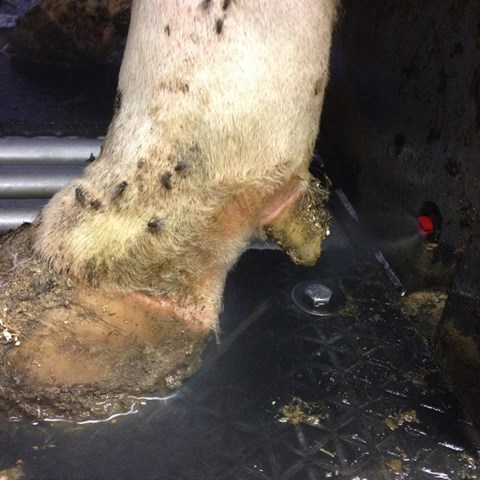Facts:
Fundings by Partnerskap Alnap and Ekoforsk.

Digital Dermatitis (DD) is a contagious claw disease which secondary cause other claw disorders (Heel horn erosion, Corns, Warts) and lameness most commonly in loose housed dairy herds. Lameness is the most common cause of impaired animal health, reduced longevity and thereby economic losses for the dairy industry. Claw diseases and lameness is increasing in pace with the change from tied to loose housed animals because of increased infection pressure and because that the feet are becoming more exposed to poor hygiene and trauma than if the animal is housed in a tie stall barn. Primary prevention of these disorders and lameness are biosecurity, good stall hygiene and maintenance foot trimming. Footbath with 8% copper sulphate solution has been recommended for long time to prevent infectious claw diseases. Swedish trials has showed that a foot bath with different solutions based on copper sulphate reduced the risk for DD ten times compared to the control using water bath. Despite copper is a pollutant covered by the European biocides directive; it is still in use in Sweden as a result of lack of alternatives. The purpose of present experiment is to study if an alternative method for application and an alternative disinfectant, which does not burden the environment, can prevent and treat digital dermatitis and secondary claw disorders and lameness. The method is to spray the rear feet with a hypochlorous acid solution when the animal is positioned in an automatic milking system. Hypochlorous acid is produced from water by means of an electric hydrolysis under constant pH 6.5 and with the addition of sodium chloride. The solution is disinfecting during application after which it returns to water and sodium chloride.
The experiment is carried out in five dairy commercial herds with at least two milking robots to be able to have a study with an experimental approach with a control group using the same management, feeding and animal materials. The hooves are examined and mouth diseases diagnosed during the trial start and after a minimum of 4 months of exposure, and the results are analyzed and accounted for.
Fundings by Partnerskap Alnap and Ekoforsk.
Christer Bergsten
Professor at the Department of Biosystems and Technology
Phone: +46(0)40-415475
E-mail: christer.bergsten@slu.se